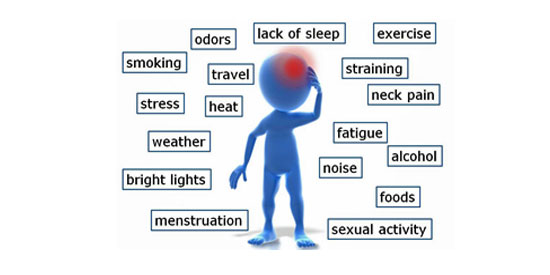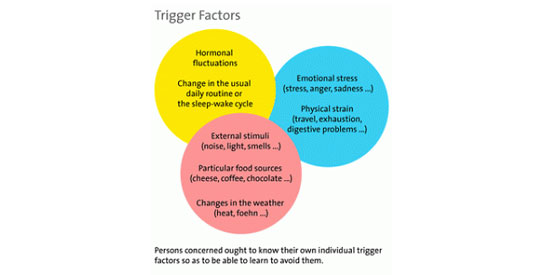
What are migraine headaches?
Migraines are painful, throbbing headaches that last from 4 to 72 hours. When you have a migraine, it may be so painful that you are not able to do your usual activities. But even though migraines make you feel bad, they don’t cause long-term damage.
Migraines are a health problem that can be treated.
What causes migraines?
Experts are not sure what causes migraines.
Migraines run in families, but it isn’t clear why some people get migraines and others don’t.
Some things can cause a migraine to start. These are called triggers. Your triggers may be different from someone else’s. Some common triggers include:
- Stress.
- Fasting or skipping meals.
- Poor sleep habits.
- A change from your normal routine.
- Red wine.
- Monosodium glutamate (MSG).
- Strong odors.
- Chocolate.

What are the symptoms?
The main symptom of a migraine is a throbbing headache on one side of your head . You also may feel sick to your stomach and vomit. Activity, light, noise, or odors may make the migraine worse. The pain may move from one side of your head to the other, or you may feel it on both sides at the same time. Different people have different symptoms.
Some people have an aura before the migraine begins. When you have an aura, you may first see spots, wavy lines, or flashing lights. Your hands, arms, or face may tingle or feel numb. The aura usually starts about 30 minutes before the headache. But most people don’t have auras.
- Migraine without aura (common migraine).Most people with migraines have common migraines. This type of migraine causes a throbbing pain on one side of the head. The pain is moderate to severe and gets worse with normal physical activity. You also may have nausea and vomiting and may feel worse around light and sound. The headache lasts 4 to 72 hours if it is not treated. A common migraine doesn’t begin with an aura.
- Migraine with aura (classic migraine).Some people with migraines get an aura up to 30 minutes before they have a migraine. Symptoms of the aura include seeing wavy lines, flashing lights, or objects that look distorted. Other symptoms include tingling or a “pins-and-needles” feeling.
- Other types of migraine headache include:
- Menstrual migraine.Many women have migraines around their menstrual cycle . These occur a few days before, during, or right after their period. The symptoms are the same as those of common or classic migraines.
- Migraine equivalent.Migraine equivalent is a migraine aura that is not followed by a headache. This form of migraine often happens after age 50 if you had migraines with aura when you were younger. The symptoms may include streaks or points of light moving across your field of vision.
- Complicated migraine.These are migraines that cause symptoms such as numbness and tingling, trouble speaking or understanding speech, or not being able to move an arm or leg. These symptoms go on after the headache goes away.
- Abdominal migraine.These migraines usually occur in children. The symptoms include vomiting or dizziness, without a throbbing headache. The symptoms may occur about once a month.
How are migraines diagnosed?
A doctor can usually tell if you have a migraine by asking about your symptoms and examining you. You probably will not need lab tests, but your doctor may order some if he or she thinks your symptoms are caused by another disease.
Triggering factors:
The most common migraine triggers are:
- Stress(either during a stressful time or right after stress subsides).
- Menstrual cycle in women.
- Changes in your routine, such as how much you exercise or how much you sleep.
- Fasting or skipping meals.
- Changes in the weather, heat, or high humidity.
- Bright lights, glare, or reflected sunlight.
- Foods, such as chocolate.
- Alcohol—all alcohol, or one type of alcohol in particular, like beer or wine.
- Odors such as perfume, paint, dust, and certain flowers.

Other migraine triggers include:
- Strong emotions, such as depression or anxiety.
- Pushing yourself too hard when you exercise.
- Aspartame.
- Monosodium glutamate (MSG).
- Nitrates, which are found in cured meats such as hot dogs, bacon, and cold cuts.
- Tyramines, which are found in pickled or marinated foods, aged cheeses, and yeast.
- Smoking or being around someone who smokes.
- Excessive caffeine or caffeine withdrawal.
- Birth control pills and hormone therapy.
- Medicines that expand (dilate) the blood vessels (vasodilators), such as nifedipine, and nitrates.
General Measures
When you feel a migraine coming on: You may have fewer migraines—and less pain when you do get them—by trying to:
- Find and avoid triggers for your headaches.
- Keep a headache diary to find out what triggers your migraines.
- Take medicine as your doctor advises to prevent and stop migraines.
- Take your medicine right away when you think that you are getting a migraine.
- Reduce stress with relaxation and positive-thinking methods.
- Get help from your doctor and a counselor if you think that your migraines may be linked to depression or anxiety. Treating these health problems may reduce how often you get migraines.
- Stop what you are doing, and take your medicine. Don’t wait for the migraine to get worse.Take your medicine exactly as your doctor told you to.
- Rest in a quiet, dark room. Close your eyes, and try to relax or go to sleep. Don’t watch TV or read. Put a cold pack or cool cloth on the painful area.
Prevention:
You may be able to have fewer migraines by finding out what brings on (or triggers) your headaches and then avoiding those triggers.
Migraine triggers include certain foods and stress.
Some common triggers are:
- Stress.
- Not eating.
- Poor sleep habits.
- A change from your normal routine.
- Heat, high humidity, or changes in the weather.
- Red wine.
- Monosodium glutamate (MSG).
- Strong odors.
- Chocolate.
